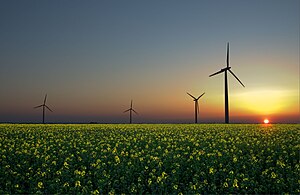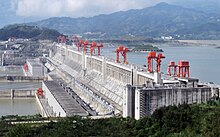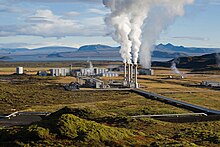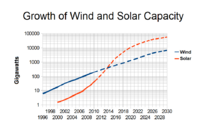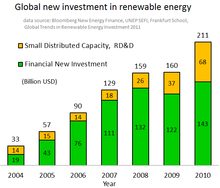From Wikipedia, the free encyclopedia
Renewable energy is generally defined as energy that comes from resources which are naturally replenished on a human timescale such as sunlight, wind, rain, tides, waves and geothermal heat.[2] Renewable energy replaces conventional fuels in four distinct areas: electricity generation, hot water/space heating, motor fuels, and rural (off-grid) energy services.[3]
Based on REN21's 2014 report, renewables contributed 19 percent to our energy consumption and 22 percent to our electricity generation in 2012 and 2013, respectively. Both, modern renewables, such as hydro, wind, solar and biofuels, as well as traditional biomass, contributed in about equal parts to the global energy supply. Worldwide investments in renewable technologies amounted to more than US$214 billion in 2013, with countries like China and the United States heavily investing in wind, hydro, solar and biofuels.[4]
Renewable energy resources exist over wide geographical areas, in contrast to other energy sources, which are concentrated in a limited number of countries. Rapid deployment of renewable energy and energy efficiency is resulting in significant energy security, climate change mitigation, and economic benefits.[5] In international public opinion surveys there is strong support for promoting renewable sources such as solar power and wind power.[6] At the national level, at least 30 nations around the world already have renewable energy contributing more than 20 percent of energy supply. National renewable energy markets are projected to continue to grow strongly in the coming decade and beyond.[7]
While many renewable energy projects are large-scale, renewable technologies are also suited to rural and remote areas and developing countries, where energy is often crucial in human development.[8] United Nations' Secretary-General Ban Ki-moon has said that renewable energy has the ability to lift the poorest nations to new levels of prosperity.[9]
Overview
Renewable energy is derived from natural processes that are replenished constantly. In its various forms, it derives directly from the sun, or from heat generated deep within the earth. Included in the definition is electricity and heat generated from solar, wind, ocean, hydropower, biomass, geothermal resources, and biofuels and hydrogen derived from renewable resources.Wind power is growing at the rate of 30% annually, with a worldwide installed capacity of 282,482 megawatts (MW) at the end of 2012, and is widely used in Europe, Asia, and the United States. At the end of 2012 the photovoltaic (PV) capacity worldwide was 100,000 MW, and PV power stations are popular in Germany and Italy. Solar thermal power stations operate in the USA and Spain, and the largest of these is the 354 MW SEGS power plant in the Mojave Desert. The world's largest geothermal power installation is The Geysers in California, with a rated capacity of 750 MW. Brazil has one of the largest renewable energy programs in the world, involving production of ethanol fuel from sugar cane, and ethanol now provides 18% of the country's automotive fuel. Ethanol fuel is also widely available in the USA.
Renewable energy resources and significant opportunities for energy efficiency exist over wide geographical areas, in contrast to other energy sources, which are concentrated in a limited number of countries. Rapid deployment of renewable energy and energy efficiency, and technological diversification of energy sources, would result in significant energy security and economic benefits.[5]
Renewable energy replaces conventional fuels in four distinct areas: electricity generation, hot water/space heating, motor fuels, and rural (off-grid) energy services:[3]
- Power generation. Renewable energy provides 21.7% of electricity generation worldwide as of 2013.[12] Renewable power generators are spread across many countries, and wind power alone already provides a significant share of electricity in some areas: for example, 14% in the U.S. state of Iowa, 40% in the northern German state of Schleswig-Holstein, and 49% in Denmark. Some countries get most of their power from renewables, including Iceland (100%), Norway (98%), Brazil (86%), Austria (62%), New Zealand (65%), and Sweden (54%).[13]
- Heating. Solar hot water makes an important contribution to renewable heat in many countries, most notably in China, which now has 70% of the global total (180 GWth). Most of these systems are installed on multi-family apartment buildings and meet a portion of the hot water needs of an estimated 50–60 million households in China. Worldwide, total installed solar water heating systems meet a portion of the water heating needs of over 70 million households. The use of biomass for heating continues to grow as well. In Sweden, national use of biomass energy has surpassed that of oil. Direct geothermal for heating is also growing rapidly.[13]
- Transport fuels. Renewable biofuels have contributed to a significant decline in oil consumption in the United States since 2006.[13] The 93 billion liters of biofuels produced worldwide in 2009 displaced the equivalent of an estimated 68 billion liters of gasoline, equal to about 5% of world gasoline production.[13]
At the national level, at least 30 nations around the world already have renewable energy contributing more than 20% of energy supply. National renewable energy markets are projected to continue to grow strongly in the coming decade and beyond, and some 120 countries have various policy targets for longer-term shares of renewable energy, including a 20% target of all electricity generated for the European Union by 2020. Some countries have much higher long-term policy targets of up to 100% renewables. Outside Europe, a diverse group of 20 or more other countries target renewable energy shares in the 2020–2030 time frame that range from 10% to 50%.[7]
Climate change and global warming concerns, coupled with high oil prices, peak oil, and increasing government support, are driving increasing renewable energy legislation, incentives and commercialization.[6] New government spending, regulation and policies helped the industry weather the global financial crisis better than many other sectors.[15] According to a 2011 projection by the International Energy Agency, solar power generators may produce most of the world's electricity within 50 years, reducing the emissions of greenhouse gases that harm the environment.[16]
Renewable energy sources, that derive their energy from the sun, either directly or indirectly, such as hydro and wind, are expected to be capable of supplying humanity energy for almost another 1 billion years, at which point the predicted increase in heat from the sun is expected to make the surface of the earth too hot for liquid water to exist.[17][18]
History
Prior to the development of coal in the mid 19th century, nearly all energy used was renewable. Almost without a doubt the oldest known use of renewable energy, in the form of traditional biomass to fuel fires, dates from 790,000 years ago. Use of biomass for fire did not become commonplace until many hundreds of thousands of years later, sometime between 200,000 and 400,000 years ago.[19]Probably the second oldest usage of renewable energy is harnessing the wind in order to drive ships over water. This practice can be traced back some 7000 years, to ships on the Nile.[20]
Moving into the time of recorded history, the primary sources of traditional renewable energy were human labor, animal power, water power, wind, in grain crushing windmills, and firewood, a traditional biomass. A graph of energy use in the United States up until 1900 shows oil and natural gas with about the same importance in 1900 as wind and solar played in 2010.
By 1873, concerns of running out of coal prompted experiments with using solar energy.[21]
Development of solar engines continued until the outbreak of World War I. The importance of solar energy was recognized in a 1911 Scientific American article: "in the far distant future, natural fuels having been exhausted [solar power] will remain as the only means of existence of the human race".[22]
The theory of peak oil was published in 1956.[23] In the 1970s environmentalists promoted the development of renewable energy both as a replacement for the eventual depletion of oil, as well as for an escape from dependence on oil, and the first electricity generating wind turbines appeared. Solar had long been used for heating and cooling, but solar panels were too costly to build solar farms until 1980.[24]
The IEA 2014 World Energy Outlook projects a growth of renewable energy supply from 1700 gigawatts in 2014 to 4550 gigawatts in 2040. Fossil fuels received about $550 billion in subsidies in 2013, compared to $120 billion for all renewable energies.[25]
Mainstream technologies
Wind power
Globally, the long-term technical potential of wind energy is believed to be five times total current global energy production, or 40 times current electricity demand, assuming all practical barriers needed were overcome. This would require wind turbines to be installed over large areas, particularly in areas of higher wind resources, such as offshore. As offshore wind speeds average ~90% greater than that of land, so offshore resources can contribute substantially more energy than land stationed turbines.[29]
Hydropower
- Hydroelectric energy is a term usually reserved for large-scale hydroelectric dams. The largest of which is the Three Gorges Dam in China and a smaller example is the Akosombo Dam in Ghana.
- Micro hydro systems are hydroelectric power installations that typically produce up to 100 kW of power. They are often used in water rich areas as a remote-area power supply (RAPS).
- Run-of-the-river hydroelectricity systems derive kinetic energy from rivers and oceans without the creation of a large reservoir.
Wave power, that captures the energy of ocean surface waves, and tidal power, converting the energy of tides, are two forms of hydropower with future potential, however, not yet widely employed commercially, while ocean thermal energy conversion, that uses the temperature difference between cooler deep and warmer surface waters, has currently no economic feasibility.
Solar energy
Solar technologies are broadly characterized as either passive solar or active solar depending on the way they capture, convert and distribute solar energy. Passive solar techniques include orienting a building to the Sun, selecting materials with favorable thermal mass or light dispersing properties, and designing spaces that naturally circulate air.
Active solar technologies encompass solar thermal energy, using solar collectors for heating, and solar power, converting sunlight into electricity either directly using photovoltaics (PV), or indirectly using concentrated solar power (CSP).
A photovoltaic system converts light into electrical direct current (DC) by taking advantage of the photoelectric effect.[33] Solar PV has turned into a multi-billion, fast-growing industry, continues to improve its cost-effectiveness, and has the most potential of any renewable technology.[34][35] Concentrated solar power systems use lenses or mirrors and tracking systems to focus a large area of sunlight into a small beam. Commercial concentrated solar power plants were first developed in the 1980s.
In 2011, the International Energy Agency said that "the development of affordable, inexhaustible and clean solar energy technologies will have huge longer-term benefits. It will increase countries' energy security through reliance on an indigenous, inexhaustible and mostly import-independent resource, enhance sustainability, reduce pollution, lower the costs of mitigating climate change, and keep fossil fuel prices lower than otherwise. These advantages are global. Hence the additional costs of the incentives for early deployment should be considered learning investments; they must be wisely spent and need to be widely shared".[31]
Biomass
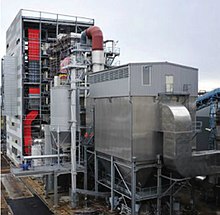
A combined heat and power plant in Metz, France. The station uses wood and supplies 30,000 households.
Wood remains the largest biomass energy source today;[37] examples include forest residues (such as dead trees, branches and tree stumps), yard clippings, wood chips and even municipal solid waste. In the second sense, biomass includes plant or animal matter that can be converted into fibers or other industrial chemicals, including biofuels. Industrial biomass can be grown from numerous types of plants, including miscanthus, switchgrass, hemp, corn, poplar, willow, sorghum, sugarcane, bamboo,[38] and a variety of tree species, ranging from eucalyptus to oil palm (palm oil).
Plant energy is produced by crops specifically grown for use as fuel that offer high biomass output per hectare with low input energy. Some examples of these plants are wheat, which typically yield 7.5–8 tonnes of grain per hectare, and straw, which typically yield 3.5–5 tonnes per hectare in the UK.[39] The grain can be used for liquid transportation fuels while the straw can be burned to produce heat or electricity. Plant biomass can also be degraded from cellulose to glucose through a series of chemical treatments, and the resulting sugar can then be used as a first generation biofuel.
Biomass can be converted to other usable forms of energy like methane gas or transportation fuels like ethanol and biodiesel. Rotting garbage, and agricultural and human waste, all release methane gas – also called "landfill gas" or "biogas". Crops, such as corn and sugar cane, can be fermented to produce the transportation fuel, ethanol. Biodiesel, another transportation fuel, can be produced from left-over food products like vegetable oils and animal fats.[40] Also, biomass to liquids (BTLs) and cellulosic ethanol are still under research.[41][42]
There is a great deal of research involving algal, or algae-derived, biomass due to the fact that it's a non-food resource and can be produced at rates 5 to 10 times those of other types of land-based agriculture, such as corn and soy. Once harvested, it can be fermented to produce biofuels such as ethanol, butanol, and methane, as well as biodiesel and hydrogen.
The biomass used for electricity generation varies by region. Forest by-products, such as wood residues, are common in the United States. Agricultural waste is common in Mauritius (sugar cane residue) and Southeast Asia (rice husks). Animal husbandry residues, such as poultry litter, are common in the UK.[43]
Biofuel
Bioethanol is an alcohol made by fermenting the sugar components of plant materials and it is made mostly from sugar and starch crops. These include maize, sugar cane and, more recently, sweet sorghum. The latter crop is particularly suitable for growing in dryland conditions, and is being investigated by ICRISAT for its potential to provide fuel, along with food and animal feed, in arid parts of Asia and Africa.[45]
With advanced technology being developed, cellulosic biomass, such as trees and grasses, are also used as feedstocks for ethanol production. Ethanol can be used as a fuel for vehicles in its pure form, but it is usually used as a gasoline additive to increase octane and improve vehicle emissions. Bioethanol is widely used in the USA and in Brazil. The energy costs for producing bio-ethanol are almost equal to, the energy yields from bio-ethanol. However, according to the European Environment Agency, biofuels do not address global warming concerns.[46]
Biodiesel is made from vegetable oils, animal fats or recycled greases. Biodiesel can be used as a fuel for vehicles in its pure form, but it is usually used as a diesel additive to reduce levels of particulates, carbon monoxide, and hydrocarbons from diesel-powered vehicles. Biodiesel is produced from oils or fats using transesterification and is the most common biofuel in Europe.
Biofuels provided 2.7% of the world's transport fuel in 2010.[47]
Geothermal energy
The heat that is used for geothermal energy can be from deep within the Earth, all the way down to Earth's core – 4,000 miles (6,400 km) down. At the core, temperatures may reach over 9,000 °F (5,000 °C). Heat conducts from the core to surrounding rock. Extremely high temperature and pressure cause some rock to melt, which is commonly known as magma. Magma convects upward since it is lighter than the solid rock. This magma then heats rock and water in the crust, sometimes up to 700 °F (371 °C).[49]
From hot springs, geothermal energy has been used for bathing since Paleolithic times and for space heating since ancient Roman times, but it is now better known for electricity generation.
Gallery
-
Sunrise at the Fenton Wind Farm in Minnesota, United States
-
-
Ivanpah solar plant in the Mojave Desert, California, United States
-
Three Gorges Dam and Gezhouba Dam, China
-
-
Stump harvesting to increases recovery of biomass from forests
-
The community-owned Westmill Solar Park in South East England
-
Photovoltaic power station in Kofu, Japan
The Whitelee Wind Farm near East Renfrewshire in Scotland, UK. Seen from beyond the Lochgoin Reservoir.
Commercialization
Growth of renewables
From the end of 2004, worldwide renewable energy capacity grew at rates of 10–60% annually for many technologies. For wind power and many other renewable technologies, growth accelerated in 2009 relative to the previous four years.[3] More wind power capacity was added during 2009 than any other renewable technology. However, grid-connected PV increased the fastest of all renewables technologies, with a 60% annual average growth rate.[3] In 2010, renewable power constituted about a third of the newly built power generation capacities.[52]
Projections vary, but scientists have advanced a plan to power 100% of the world's energy with wind, hydroelectric, and solar power by the year 2030.[53][54]
According to a 2011 projection by the International Energy Agency, solar power generators may produce most of the world's electricity within 50 years, reducing the emissions of greenhouse gases that harm the environment. Cedric Philibert, senior analyst in the renewable energy division at the IEA said: "Photovoltaic and solar-thermal plants may meet most of the world's demand for electricity by 2060 – and half of all energy needs – with wind, hydropower and biomass plants supplying much of the remaining generation". "Photovoltaic and concentrated solar power together can become the major source of electricity", Philibert said.[16]
| Selected renewable energy global indicators | 2008 | 2009 | 2010 | 2011 | 2012 | 2013 | |
|---|---|---|---|---|---|---|---|
| Investment in new renewable capacity (annual) (109 USD) | 130 | 160 | 211 | 257 | 244 | 214 | |
| Renewables power capacity (existing) (GWe) | 1,140 | 1,230 | 1,320 | 1,360 | 1,470 | 1,560 | |
| Hydropower capacity (existing) (GWe) | 885 | 915 | 945 | 970 | 990 | 1,000 | |
| Wind power capacity (existing) (GWe) | 121 | 159 | 198 | 238 | 283 | 318 | |
| Solar PV capacity (grid-connected) (GWe) | 16 | 23 | 40 | 70 | 100 | 139 | |
| Solar hot water capacity (existing) (GWth) | 130 | 160 | 185 | 232 | 255 | 326 | |
| Ethanol production (annual) (109 litres) | 67 | 76 | 86 | 86 | 83 | 87 | |
| Biodiesel production (annual) (109 litres) | 12 | 17.8 | 18.5 | 21.4 | 22.5 | 26 | |
| Countries with policy targets for renewable energy use |
79 | 89 | 98 | 118 | 138 | 144 | |
| Source: The Renewable Energy Policy Network for the 21st Century (REN21)–Global Status Report[55][56][57][58] Next report: Release of GSR2015, with figures for 2014, is expected in June/July 2015. |
|||||||
Economic trends
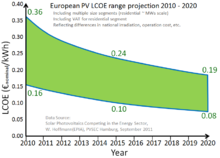
Levelized cost projection for solar PV in the EU (September 2011). Germany already reached cost-range of €0.08–0.14 per kWh in 2013.[59]
Renewable energy technologies are getting cheaper, through technological change and through the benefits of mass production and market competition. A 2011 IEA report said: "A portfolio of renewable energy technologies is becoming cost-competitive in an increasingly broad range of circumstances, in some cases providing investment opportunities without the need for specific economic support," and added that "cost reductions in critical technologies, such as wind and solar, are set to continue."[60]
Hydro-electricity and geothermal electricity produced at favourable sites are now the cheapest way to generate electricity. Renewable energy costs continue to drop, and the levelised cost of electricity (LCOE) is declining for wind power, solar photovoltaic (PV), concentrated solar power (CSP) and some biomass technologies.[61]

The National Renewable Energy Laboratory projects that the levelized cost of wind power will decline 25% from 2012 to 2030.[62]
Renewable energy is also the most economic solution for new grid-connected capacity in areas with good resources. As the cost of renewable power falls, the scope of economically viable applications increases. Renewable technologies are now often the most economic solution for new generating capacity. Where "oil-fired generation is the predominant power generation source (e.g. on islands, off-grid and in some countries) a lower-cost renewable solution almost always exists today".[61]
A series of studies by the US National Renewable Energy Laboratory modeled the "grid in the Western US under a number of different scenarios where intermittent renewables accounted for 33 percent of the total power." In the models, inefficiencies in cycling the fossil fuel plants to compensate for the variation in solar and wind energy resulted in an additional cost of "between $0.47 and $1.28 to each MegaWatt hour generated"; however, the savings in the cost of the fuels saved "adds up to $7 billion, meaning the added costs are, at most, two percent of the savings."[63]
Hydroelectricity
The Three Gorges Dam in Hubei, China, has the world's largest instantaneous generating capacity (22,500 MW), with the Itaipu Dam in Brazil/Paraguay in second place (14,000 MW). The Three Gorges Dam is operated jointly with the much smaller Gezhouba Dam (3,115 MW). As of 2012[update], the total generating capacity of this two-dam complex is 25,615 MW. In 2008, this complex generated 98 TWh of electricity (81 TWh from the Three Gorges Dam and 17 TWh from the Gezhouba Dam), which is 3% more power in one year than the 95 TWh generated by Itaipu in 2008.Wind power development
Several countries have achieved relatively high levels of wind power penetration, such as 21% of stationary electricity production in Denmark,[67] 18% in Portugal,[67] 16% in Spain,[67] 14% in Ireland[68] and 9% in Germany in 2010 and have since continued to expand their installed capacity[67] More than 80 countries around the world are using wind power on a commercial basis.[47]
- As of 2014, offshore wind power amounted to 8,771 megawatt of global installed capacity. Although offshore capacity doubled within three years (from 4,117 MW in 2011), it accounted for only 2.3% of the total wind power capacity. The United Kingdom is the undisputed leader of offshore power with half of the world's installed capacity ahead of Denmark, Germany, Belgium and China.
- As of 2012, the Alta Wind Energy Center (California, 1,020 MW) is the world's largest wind farm.[69] The London Array (630 MW) is the largest offshore wind farm in the world. The United Kingdom is the world's leading generator of offshore wind power, followed by Denmark.[70] There are several large wind farms under construction and these include Anholt Offshore Wind Farm (400 MW), BARD Offshore 1 (400 MW), Clyde Wind Farm (548 MW), Fântânele-Cogealac Wind Farm (600 MW), Greater Gabbard wind farm (500 MW), Lincs Wind Farm (270 MW), London Array (1000 MW), Lower Snake River Wind Project (343 MW), Macarthur Wind Farm (420 MW), Shepherds Flat Wind Farm (845 MW), and the Sheringham Shoal (317 MW).
| Country | Capacity (MW) |
% of Total |
|---|---|---|
| China | 114,763 | 31.0 |
| United States | 65,879 | 17.8 |
| Germany | 39,165 | 10.6 |
| Spain | 22,987 | 6.2 |
| India | 22,465 | 6.1 |
| United Kingdom | 12,440 | 3.4 |
| Canada | 9,694 | 2.6 |
| France | 9,285 | 2.5 |
| Italy | 8,663 | 2.3 |
| Brazil | 5,939 | 1.6 |
| (rest of world) | 58,275 | 15.8 |
| World total | 369,553 | 100% |
| Source: GWEC—Global Wind Statistics 2014.[64] Note: Nameplate capacity is shown. Figures by year-end; tentative for China and Brazil. | ||
Solar thermal
The oldest solar thermal power plant in the world is the 354 megawatt (MW) SEGS thermal power plant, in California.[71] The Ivanpah Solar Electric Generating System is a solar thermal power project in the California Mojave Desert, 40 miles (64 km) southwest of Las Vegas, with a gross capacity of 377 MW.[72] The 280 MW Solana Generating Station is a solar power plant near Gila Bend, Arizona, about 70 miles (110 km) southwest of Phoenix, completed in 2013. When commissioned it was the largest parabolic trough plant in the world and the first U.S. solar plant with molten salt thermal energy storage.[73]
The solar thermal power industry is growing rapidly with 1.3 GW under construction in 2012 and more planned. Spain is the epicenter of solar thermal power development with 873 MW under construction, and a further 271 MW under development.[74] In the United States, 5,600 MW of solar thermal power projects have been announced.[75] Several power plants have been constructed in the Mojave Desert, Southwestern United States. The Ivanpah Solar Power Facility being the most recent. In developing countries, three World Bank projects for integrated solar thermal/combined-cycle gas-turbine power plants in Egypt, Mexico, and Morocco have been approved.[76]
Photovoltaic development
in MW grouped by region[77]
25,000
50,000
75,000
100,000
125,000
150,000
2001
2007
2013
At the end of 2013, worldwide PV capacity reached 139,000 megawatts. Photovoltaics grew fastest in China (+11.8 GW), followed by Japan (+6.9 GW) and the United States (+4.75 GW), while Germany remains the world's largest overall producer of photovoltaic power with a total capacity of 35.5 GW, contributing almost 6 percent to the overall electricity generation. Italy meets 7 percent of its electricity demands with photovoltaic power—the highest share worldwide.
For 2014, global photovoltaic capacity is estimated to increase by another 45 gigawatts (GW).[81] By 2018, worldwide capacity is projected to reach as much as 430 gigawatts. This corresponds to a tripling within five years.[77] Solar power is expected to become the world's largest source of electricity by 2050, with solar photovoltaics (PV) and solar thermal (CSP) contributing 16% and 11% respectively. This will require an increase of installed PV capacity from 139 GW to 4,600 GW, of which more than half will be deployed in China and India.[82]
Photovoltaic power stations
Many solar photovoltaic power stations have been built, mainly in Europe.[83] As of May 2012, the largest photovoltaic (PV) power plants in the world are the Agua Caliente Solar Project (USA, 247 MW), Charanka Solar Park (India, 214 MW), Golmud Solar Park (China, 200 MW), Perovo Solar Park (Ukraine, 100 MW), Sarnia Photovoltaic Power Plant (Canada, 97 MW), Brandenburg-Briest Solarpark (Germany, 91 MW), Solarpark Finow Tower (Germany, 84.7 MW), Montalto di Castro Photovoltaic Power Station (Italy, 84.2 MW), and the Eggebek Solar Park (Germany, 83.6 MW).[83]There are also many large plants under construction. The Desert Sunlight Solar Farm is a 550 MW solar power plant under construction in Riverside County, California, that will use thin-film solar photovoltaic modules made by First Solar.[84] The Topaz Solar Farm is a 550 MW photovoltaic power plant, being built in San Luis Obispo County, California.[85] The Blythe Solar Power Project is a 500 MW photovoltaic station under construction in Riverside County, California. The California Valley Solar Ranch (CVSR) is a 250 MW solar photovoltaic power plant, which is being built by SunPower in the Carrizo Plain, northeast of California Valley.[86] The 230 MW Antelope Valley Solar Ranch is a First Solar photovoltaic project which is under construction in the Antelope Valley area of the Western Mojave Desert, and due to be completed in 2013.[87]
Many of these plants are integrated with agriculture and some use tracking systems that follow the sun's daily path across the sky to generate more electricity than fixed-mounted systems. There are no fuel costs or emissions during operation of the power stations.
However, when it comes to renewable energy systems and PV, it is not just large systems that matter. Building-integrated photovoltaics or "onsite" PV systems use existing land and structures and generate power close to where it is consumed.[88]
Carbon-neutral and negative fuels
Carbon-neutral fuels are synthetic fuels (including methane, gasoline, diesel fuel, jet fuel or ammonia[89]) produced by hydrogenating waste carbon dioxide recycled from power plant flue-gas emissions, recovered from automotive exhaust gas, or derived from carbonic acid in seawater.[90] Such fuels are considered carbon-neutral because they do not result in a net increase in atmospheric greenhouse gases.[91] To the extent that synthetic fuels displace fossil fuels, or if they are produced from waste carbon or seawater carbonic acid,[92] and their combustion is subject to carbon capture at the flue or exhaust pipe, they result in negative carbon dioxide emission and net carbon dioxide removal from the atmosphere, and thus constitute a form of greenhouse gas remediation.[93]Such renewable fuels alleviate the costs and dependency issues of imported fossil fuels without requiring either electrification of the vehicle fleet or conversion to hydrogen or other fuels, enabling continued compatible and affordable vehicles.[94] Carbon-neutral fuels offer relatively low cost energy storage, alleviating the problems of wind and solar intermittency, and they enable distribution of wind, water, and solar power through existing natural gas pipelines.[94] Nighttime wind power is considered the most economical form of electrical power with which to synthesize fuel, because the load curve for electricity peaks sharply during the warmest hours of the day, but wind tends to blow slightly more at night than during the day, so, the price of nighttime wind power is often much less expensive than any alternative.[94] Germany has built a 250 kilowatt synthetic methane plant which they are scaling up to 10 megawatts.[95][96][97]
The George Olah carbon dioxide recycling plant in Grindavík, Iceland has been producing 2 million liters of methanol transportation fuel per year from flue exhaust of the Svartsengi Power Station since 2011.[98] It has the capacity to produce 5 million liters per year.[99]
Biofuel development
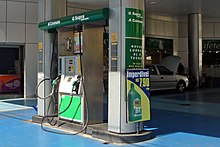
Brazil produces bioethanol made from sugarcane available throughout the country. A typical gas station with dual fuel service is marked "A" for alcohol (ethanol) and "G" for gasoline.
Since the 1970s, Brazil has had an ethanol fuel program which has allowed the country to become the world's second largest producer of ethanol (after the United States) and the world's largest exporter.[101] Brazil's ethanol fuel program uses modern equipment and cheap sugarcane as feedstock, and the residual cane-waste (bagasse) is used to produce heat and power.[102] There are no longer light vehicles in Brazil running on pure gasoline. By the end of 2008 there were 35,000 filling stations throughout Brazil with at least one ethanol pump.[103]
Nearly all the gasoline sold in the United States today is mixed with 10% ethanol, a mix known as E10,[104] and motor vehicle manufacturers already produce vehicles designed to run on much higher ethanol blends. Ford, Daimler AG, and GM are among the automobile companies that sell "flexible-fuel" cars, trucks, and minivans that can use gasoline and ethanol blends ranging from pure gasoline up to 85% ethanol (E85). By mid-2006, there were approximately 6 million E85-compatible vehicles on U.S. roads.[105] The challenge is to expand the market for biofuels beyond the farm states where they have been most popular to date. Flex-fuel vehicles are assisting in this transition because they allow drivers to choose different fuels based on price and availability. The Energy Policy Act of 2005, which calls for 7.5 billion US gallons (28,000,000 m3) of biofuels to be used annually by 2012, will also help to expand the market.[105]
Geothermal development
The International Geothermal Association (IGA) has reported that 10,715 MW of geothermal power in 24 countries is online, which is expected to generate 67,246 GWh of electricity in 2010.[107] This represents a 20% increase in geothermal power online capacity since 2005. IGA projects this will grow to 18,500 MW by 2015, due to the large number of projects presently under consideration, often in areas previously assumed to have little exploitable resource.[107]
In 2010, the United States led the world in geothermal electricity production with 3,086 MW of installed capacity from 77 power plants;[108] the largest group of geothermal power plants in the world is located at The Geysers, a geothermal field in California.[109] The Philippines follows the US as the second highest producer of geothermal power in the world, with 1,904 MW of capacity online; geothermal power makes up approximately 18% of the country's electricity generation.[108]
Developing countries
Technology advances are opening up a huge new market for solar power: the approximately 1.3 billion people around the world who don't have access to grid electricity. Even though they are typically very poor, these people have to pay far more for lighting than people in rich countries because they use inefficient kerosene lamps. Solar power costs half as much as lighting with kerosene.[111] An estimated 3 million households get power from small solar PV systems.[112] Kenya is the world leader in the number of solar power systems installed per capita. More than 30,000 very small solar panels, each producing 12 to 30 watts, are sold in Kenya annually. Some Small Island Developing States (SIDS) are also turning to solar power to reduce their costs and increase their sustainability.[113]
Micro-hydro configured into mini-grids also provide power. Over 44 million households use biogas made in household-scale digesters for lighting and/or cooking, and more than 166 million households rely on a new generation of more-efficient biomass cookstoves.[14] Clean liquid fuel sourced from renewable feedstocks are used for cooking and lighting in energy-poor areas of the developing world. Alcohol fuels (ethanol and methanol) can be produced sustainably from non-food sugary, starchy, and cellulostic feedstocks. Project Gaia, Inc. and CleanStar Mozambique are implementing clean cooking programs with liquid ethanol stoves in Ethiopia, Kenya, Nigeria and Mozambique.[114]
Renewable energy projects in many developing countries have demonstrated that renewable energy can directly contribute to poverty reduction by providing the energy needed for creating businesses and employment. Renewable energy technologies can also make indirect contributions to alleviating poverty by providing energy for cooking, space heating, and lighting. Renewable energy can also contribute to education, by providing electricity to schools.[115]
Industry and policy trends
The military has also focused on the use of renewable fuels for military vehicles. Unlike fossil fuels, renewable fuels can be produced in any country, creating a strategic advantage. The US military has already committed itself to have 50% of its energy consumption come from alternative sources.[119]
The International Renewable Energy Agency (IRENA) is an intergovernmental organization for promoting the adoption of renewable energy worldwide. It aims to provide concrete policy advice and facilitate capacity building and technology transfer. IRENA was formed on 26 January 2009, by 75 countries signing the charter of IRENA.[120] As of March 2010, IRENA has 143 member states who all are considered as founding members, of which 14 have also ratified the statute.[121]
As of 2011, 119 countries have some form of national renewable energy policy target or renewable support policy. National targets now exist in at least 98 countries. There is also a wide range of policies at state/provincial and local levels.[47]
United Nations' Secretary-General Ban Ki-moon has said that renewable energy has the ability to lift the poorest nations to new levels of prosperity.[9] In October 2011, he "announced the creation of a high-level group to drum up support for energy access, energy efficiency and greater use of renewable energy. The group is to be co-chaired by Kandeh Yumkella, the chair of UN Energy and director general of the UN Industrial Development Organisation, and Charles Holliday, chairman of Bank of America".[122]
100% renewable energy
The incentive to use 100% renewable energy, for electricity, transport, or even total primary energy supply globally, has been motivated by global warming and other ecological as well as economic concerns. The Intergovernmental Panel on Climate Change has said that there are few fundamental technological limits to integrating a portfolio of renewable energy technologies to meet most of total global energy demand. Renewable energy use has grown much faster than even advocates anticipated.[123] At the national level, at least 30 nations around the world already have renewable energy contributing more than 20% of energy supply. Also, Professors S. Pacala and Robert H. Socolow have developed a series of “stabilization wedges” that can allow us to maintain our quality of life while avoiding catastrophic climate change, and "renewable energy sources," in aggregate, constitute the largest number of their "wedges." [124]Mark Z. Jacobson, professor of civil and environmental engineering at Stanford University and director of its Atmosphere and Energy Program says producing all new energy with wind power, solar power, and hydropower by 2030 is feasible and existing energy supply arrangements could be replaced by 2050. Barriers to implementing the renewable energy plan are seen to be "primarily social and political, not technological or economic". Jacobson says that energy costs with a wind, solar, water system should be similar to today's energy costs.[125]
Similarly, in the United States, the independent National Research Council has noted that “sufficient domestic renewable resources exist to allow renewable electricity to play a significant role in future electricity generation and thus help confront issues related to climate change, energy security, and the escalation of energy costs … Renewable energy is an attractive option because renewable resources available in the United States, taken collectively, can supply significantly greater amounts of electricity than the total current or projected domestic demand." .[126]
The most significant barriers to the widespread implementation of large-scale renewable energy and low carbon energy strategies are primarily political and not technological. According to the 2013 Post Carbon Pathways report, which reviewed many international studies, the key roadblocks are: climate change denial, the fossil fuels lobby, political inaction, unsustainable energy consumption, outdated energy infrastructure, and financial constraints.[127]
Emerging technologies
Other renewable energy technologies are still under development, and include cellulosic ethanol, hot-dry-rock geothermal power, and ocean energy.[128] These technologies are not yet widely demonstrated or have limited commercialization. Many are on the horizon and may have potential comparable to other renewable energy technologies, but still depend on attracting sufficient attention and research, development and demonstration (RD&D) funding.[128]There are numerous organizations within the academic, federal, and commercial sectors conducting large scale advanced research in the field of renewable energy. This research spans several areas of focus across the renewable energy spectrum. Most of the research is targeted at improving efficiency and increasing overall energy yields.[129] Multiple federally supported research organizations have focused on renewable energy in recent years. Two of the most prominent of these labs are Sandia National Laboratories and the National Renewable Energy Laboratory (NREL), both of which are funded by the United States Department of Energy and supported by various corporate partners.[130] Sandia has a total budget of $2.4 billion[131] while NREL has a budget of $375 million.[132]
Cellulosic ethanol
Companies such as Iogen, POET, and Abengoa are building refineries that can process biomass and turn it into ethanol, while companies such as the Verenium Corporation, Novozymes, and Dyadic International are producing enzymes which could enable a cellulosic ethanol future. The shift from food crop feedstocks to waste residues and native grasses offers significant opportunities for a range of players, from farmers to biotechnology firms, and from project developers to investors.[133]| Company | Location | Feedstock |
|---|---|---|
| Abengoa Bioenergy | Hugoton, KS | Wheat straw |
| BlueFire Renewables | Irvine, CA | Multiple sources |
| Gulf Coast Energy | Mossy Head, FL | Wood waste |
| Mascoma | Lansing, MI | Wood |
| POET | Emmetsburg, IA | Corn cobs |
| SunOpta | Little Falls, MN | Wood chips |
| Xethanol | Auburndale, FL | Citrus peels |
Marine energy

Enhanced geothermal system 1:Reservoir 2:Pump house 3:Heat exchanger 4:Turbine hall 5:Production well 6:Injection well 7:Hot water to district heating 8:Porous sediments 9:Observation well 10:Crystalline bedrock
Marine energy (also sometimes referred to as ocean energy) refers to the energy carried by ocean waves, tides, salinity, and ocean temperature differences. The movement of water in the world's oceans creates a vast store of kinetic energy, or energy in motion. This energy can be harnessed to generate electricity to power homes, transport and industries.
The term marine energy encompasses both wave power – power from surface waves, and tidal power – obtained from the kinetic energy of large bodies of moving water. Offshore wind power is not a form of marine energy, as wind power is derived from the wind, even if the wind turbines are placed over water.
The oceans have a tremendous amount of energy and are close to many if not most concentrated populations. Ocean energy has the potential of providing a substantial amount of new renewable energy around the world.[136]
Enhanced geothermal systems
Enhanced geothermal systems are a new type of geothermal power technologies that do not require natural convective hydrothermal resources. The vast majority of geothermal energy within drilling reach is in dry and non-porous rock.[140] EGS technologies "enhance" and/or create geothermal resources in this "hot dry rock (HDR)" through hydraulic stimulation.EGS / HDR technologies, like hydrothermal geothermal, are expected to be baseload resources which produce power 24 hours a day like a fossil plant. Distinct from hydrothermal, HDR / EGS may be feasible anywhere in the world, depending on the economic limits of drill depth. Good locations are over deep granite covered by a thick (3–5 km) layer of insulating sediments which slow heat loss.[141] There are HDR and EGS systems currently being developed and tested in France, Australia, Japan, Germany, the U.S. and Switzerland. The largest EGS project in the world is a 25 megawatt demonstration plant currently being developed in the Cooper Basin, Australia. The Cooper Basin has the potential to generate 5,000–10,000 MW.

